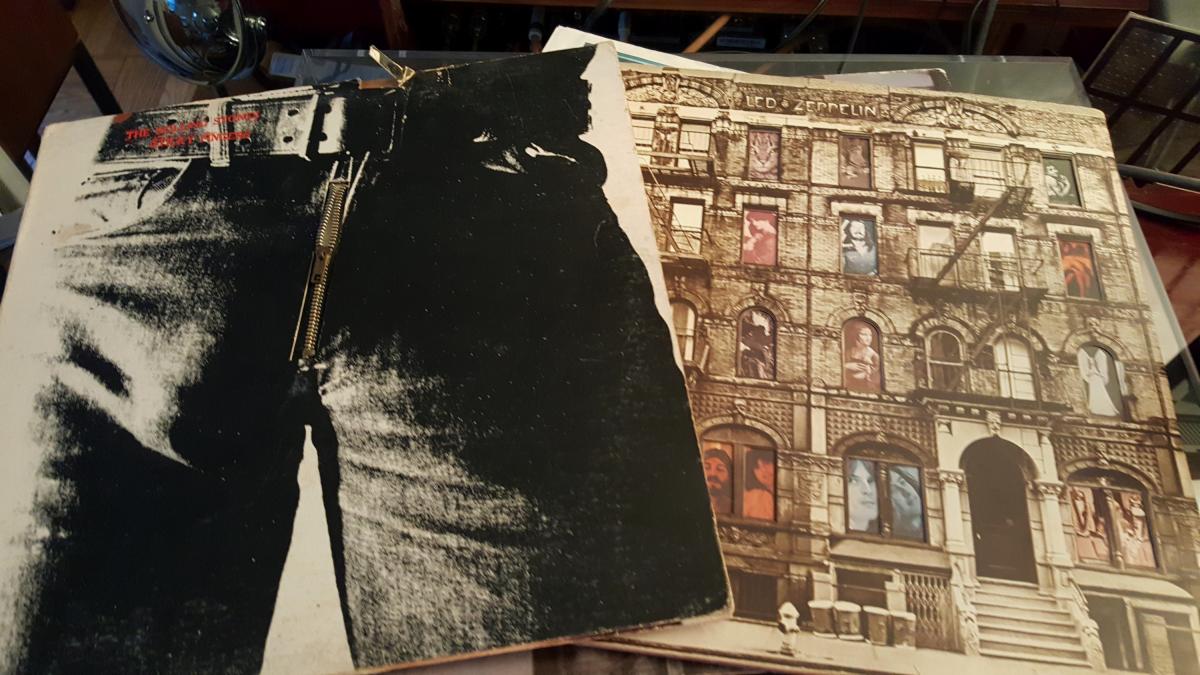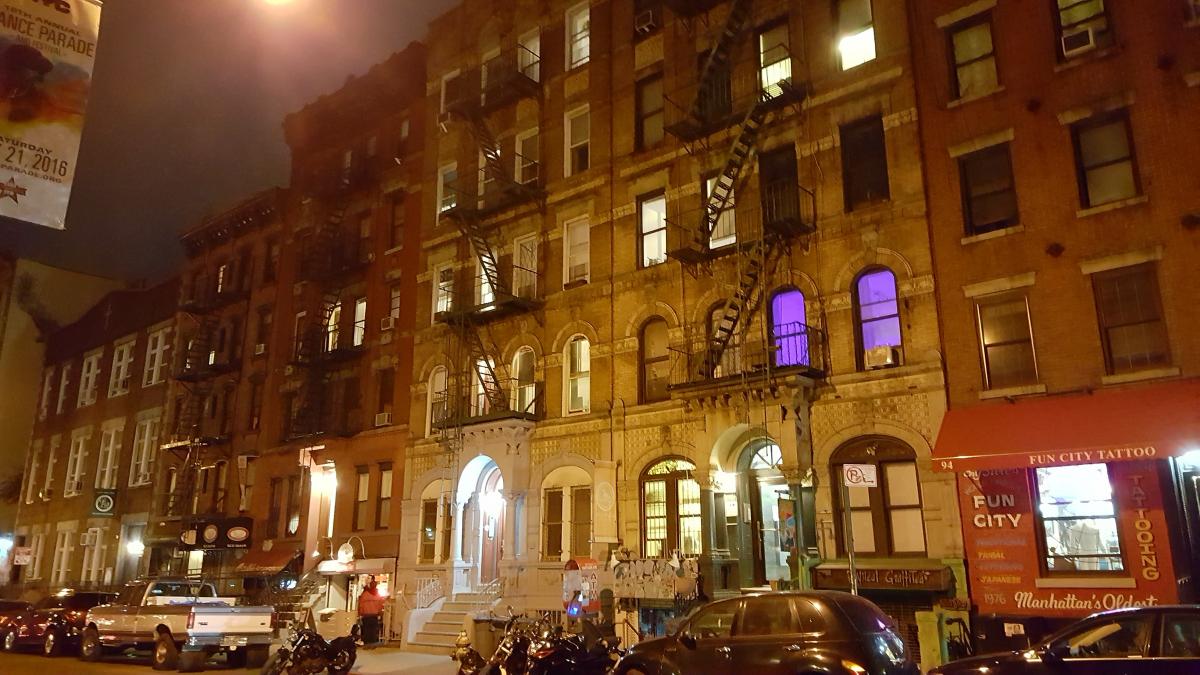| | 06/01/2016 |  Several nights ago I was walking with my wife in the East Village (searching for dessert) when she pointed out that we were walking by the buildings on Led Zeppelin's 1972 Physical Graffiti album cover. It had never occurred to me that the buildings were somewhere - let alone New York. I would have guessed London - although when you think about the buildings they really aren't in a London style. These days some might call the buildings "tenements" but they weren't. "Walk-ups" would be a better name - You can tell by the decoration and size that they were typical middle class apartments of the late 19th / early 20th century. Actually pretty fancy. And these days expensive. And I bet the landlord even gets a little premium because it's cool living in an album cover. Several nights ago I was walking with my wife in the East Village (searching for dessert) when she pointed out that we were walking by the buildings on Led Zeppelin's 1972 Physical Graffiti album cover. It had never occurred to me that the buildings were somewhere - let alone New York. I would have guessed London - although when you think about the buildings they really aren't in a London style. These days some might call the buildings "tenements" but they weren't. "Walk-ups" would be a better name - You can tell by the decoration and size that they were typical middle class apartments of the late 19th / early 20th century. Actually pretty fancy. And these days expensive. And I bet the landlord even gets a little premium because it's cool living in an album cover.
What is important is what happened to vinyl records, record art, and their revival. The original album release was a big deal. Maybe no bigger than an album by Beyonce or Adele and of course I was younger then so I paid more attention. But the album release meant hundreds of thousands of people didn't just listen to the radio and buy the record. They bought a souvenir - the record itself. Well known artists, with big budgets, were hired to create the art that made a 12" x 12" cardboard container interesting. It could be the working zipper on the Rolling Stones "Sticky Fingers" (by Andy Warhol), the cutout mustaches that came with "Sgt. Pepper", or the big poster that came with the Clash's "Sandinista". (And I still have all of this ephermera somewhere). I suppose this is just like hiring a famous filmmaker to make a music video today.
Album art for the masses disappeared with the advent of ITunes and streaming replacing record stores.
In the case of Physical Graffiti all the windows in the buildings are punched out so we can see what's going on in the apartments, just like real windows, and the cut outs give everything depth.
 But vinyl sales have come back in a small, but fast growing way. They cost a lot more than the $6.95 of my youth. In many cases they are limited editions. They are bought by hard core fans who want to participate more in the music and small groups of collectors who want to enjoy the physicality that actually getting up to play an album requires. It's a limited market but it's a real market. Oh, and the total gross of vinyl exceeds the total gross of all revenue from streaming music. But vinyl sales have come back in a small, but fast growing way. They cost a lot more than the $6.95 of my youth. In many cases they are limited editions. They are bought by hard core fans who want to participate more in the music and small groups of collectors who want to enjoy the physicality that actually getting up to play an album requires. It's a limited market but it's a real market. Oh, and the total gross of vinyl exceeds the total gross of all revenue from streaming music.
It's a lot like the furniture market today. The traditional market of furniture made to order has disappeared. Worse, average Americans are less interested in fancy furniture than ever before. Even formally custom items such as kitchens are increasingly assemblages of stock items. What people do buy is on average not meant for longevity, and is less expensive than the cost of the materials for a typical American woodworker.
What's a cabinetmaker to do?
Following the vinyl model is one way. Ignore the idea that everyone needs a table and chairs. The average person will never be your customer. You can't compete with Ikea, Walmart, or even Ethan-Allan. Pump up your prices so not only will you make a decent living for actually making the stuff you will have a budget for marketing, marketing materials, and that can include travel, commissions for agents, and other hopefully original ideas to get the word out. Oh - and very important - the stuff you make has to look like it's worth what you charge, which is in the eye of the beholder. But if someone asks you why your chair costs so much you need to have a reason better than it took 20 hours to make. This is important. Nobody cares about the blood, sweat, & tears you put into a project. People care about what it means to them. Furniture is about a lot more than just having a place to sit. If someone looks at the dresser you made (or design you showed them) and thinks - Oh wow - This will make my spouse and I feel happy - finally something that shows we care how the undies are stowed - and what's ten grand in the cosmic equation of happiness? You make a sale. Okay that's a really flippant reason, but making someone feel good about having a room filled with stuff that validates their taste, makes them feel good about their success, or makes them feel happier about living where they live is a real valid reason why people buy the things they do. Now that bit about ten grand is about having access to well heeled customers but the rest is about design and craft. By the way, a good decorator or architect looking at your stuff will hopefully think "This is just wonderful - it raises the quality of all my offerings, I can get it customized just for my clients, and I have enough clients with money who are just aching to give it to me" can be just as effective as filling up your order book.
You know when I kick back with my vinyl copy of Physical Graffiti on my turntable and I look at my stereo system blinking at me on my custom stereo stand I built myself many many years ago I think - no matter how stressful the day is -- life is good.
PW - Big Festool Demo this coming weekend at the shop - 11am-2pm -or later - click here for more info
| Join the conversation | |
| The opinions expressed in this blog are those of the blog's author and guests and in no way reflect the views of Tools for Working Wood. |
|
 Joel's Blog
Joel's Blog Built-It Blog
Built-It Blog Video Roundup
Video Roundup Classes & Events
Classes & Events Work Magazine
Work Magazine


 Several nights ago I was walking with my wife in the East Village (searching for dessert) when she pointed out that we were walking by the buildings on Led Zeppelin's 1972 Physical Graffiti album cover. It had never occurred to me that the buildings were somewhere - let alone New York. I would have guessed London - although when you think about the buildings they really aren't in a London style. These days some might call the buildings "tenements" but they weren't. "Walk-ups" would be a better name - You can tell by the decoration and size that they were typical middle class apartments of the late 19th / early 20th century. Actually pretty fancy. And these days expensive. And I bet the landlord even gets a little premium because it's cool living in an album cover.
Several nights ago I was walking with my wife in the East Village (searching for dessert) when she pointed out that we were walking by the buildings on Led Zeppelin's 1972 Physical Graffiti album cover. It had never occurred to me that the buildings were somewhere - let alone New York. I would have guessed London - although when you think about the buildings they really aren't in a London style. These days some might call the buildings "tenements" but they weren't. "Walk-ups" would be a better name - You can tell by the decoration and size that they were typical middle class apartments of the late 19th / early 20th century. Actually pretty fancy. And these days expensive. And I bet the landlord even gets a little premium because it's cool living in an album cover.  But vinyl sales have come back in a small, but fast growing way. They cost a lot more than the $6.95 of my youth. In many cases they are limited editions. They are bought by hard core fans who want to participate more in the music and small groups of collectors who want to enjoy the physicality that actually getting up to play an album requires. It's a limited market but it's a real market. Oh, and the total gross of vinyl exceeds the total gross of all revenue from streaming music.
But vinyl sales have come back in a small, but fast growing way. They cost a lot more than the $6.95 of my youth. In many cases they are limited editions. They are bought by hard core fans who want to participate more in the music and small groups of collectors who want to enjoy the physicality that actually getting up to play an album requires. It's a limited market but it's a real market. Oh, and the total gross of vinyl exceeds the total gross of all revenue from streaming music.
What's your secret prized possession?
If I told you it wouldn't be secret now, would it?
joel
Try it, you may be surprised!